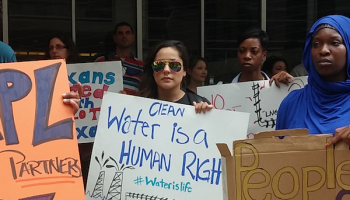
An expanse of turf maintained to golf course standards has become the image of the ideal American lawn. How our yards look is important. But how important?
Important enough to use chemicals that warn us to keep off the grass for 24 hours? Chemicals that may cling to the grass and plants longer than this period? Chemicals that have been shown to cause fatigue, headaches, dizziness, nausea, birth defects, learning difficulties, reproductive problems... cancer?
Reasons to Cut Out the Chemicals
-
Pesticides are harmful to human health and the environment.
-
Pesticides can reduce the biological activity in the soil, resulting in slowed natural decomposition and leading to thatch.
-
Pesticides and synthetic fertilizers will kill or drive away beneficial organisms in the soil and yard.
-
Pesticides and synthetic fertilizers can run off our yards and enter local waterways (our source for summer fun and drinking water).
-
Grass should be a safe place for children, pets, and bare feet.
-
A healthy lawn does not need them.
GardenGreen Pesticide-Free Brochure
Wise Watering
-
Turn on sprinklers or set timers to water between 5 a.m. and 8 a.m.
-
Water deeply and only when needed (every few days, not every day).
-
Cancel a scheduled watering if a recent rainfall has occurred.
-
If a fertilizer has just been applied, only water the lawn lightly.
Watering prevents the grass from becoming dormant during summer's high temperatures. Proper watering ensures a denser lawn and allows the turf to compete more effectively with weeds. A healthy lawn will also reduce pest problems.
Watering should take place before intense sunlight causes too much water to be lost to evaporation. Watering in the early evenings will leave the lawn damp all night, and may increase the lawns susceptibility to fungus and molds. Deep watering encourages deep root growth. However, when fertilizer has just been applied it is better to water lightly to prevent the fertilizer from leaching past the root zone, where it will not be useful to the grass.
Lawn Mowing Tricks That Make Turf Tough
Let it grow - mow high
- Set mower blades to 3 inches.
- Growing your lawn taller is an excellent way to reduce herbicide use.
Tall grass:
- Is more stress tolerant, which is especially important during the intense summer heat.
- Has a larger root structure, which increases uptake of water and nutrients.
- Provides shade, reducing weed seed germination, particularly crab grass.
Twice a year - mow low
- Twice a year your lawn should be cut to a height of 2 inches.
- The first cut in the spring and the last cut in the fall should be low. In the spring this removes any winter fungus and in the fall prevents fungus from getting established during the winter.
Give The Grass a Clean Cut
- Keep your mower blade sharp.
- Mow when the grass is dry.
- Mow in the cool part of the afternoon or evening.
- Mowing when the grass is wet or with a dull blade can cause the tip of the grass to shred, giving the lawn a brown appearance as the tips dry out, and making the grass more susceptible to disease. Cutting the grass in the intense heat can cause stress to the plant.
Mulch Clippings
- Leave grass clippings on the lawn.
- Mulching reduces the need for fertilizer since important plant nutrients are returned to the soil. A mulching mower circulates the grass clippings in the mowing chamber to produce smaller clippings which break down more easily.
Lawn Mowing Tricks for Tough Turf
Fertilize
-
Test your soil
-
Use a non-synthetic slow release fertilizer
-
Fertilize twice a year, once in May or June and once in September or October
-
Brush fertilizer that falls onto driveway and sidewalk back onto the lawn.
Properly conditioned soil provides vital nutrients to plants, retains water, and supports many micro-organisms and insects. All of these elements are important to growing a healthy lawn. A soil test kit (available at hardware or gardening stores) or a soil test provided by a lawn company, will tell you what nutrients your soil requires. Only add the necessary nutrients. Mulching decreases the number of fertilizer applications required, as the grass clippings nourish the soil. In the fall, the grass has stopped significant blade growth but has increased storage of food in the roots. Fertilizing in the fall will promote fast green-up in the spring and delay the need for spring fertilization. If any fertilizer falls on the driveway, street, or any other impervious surface, brush it back onto the lawn where it can be used. Otherwise, the fertilizer will be washed immediately into the storm drains.
Zero Phosphorus, Organic Fertilizer Options
Aerate
-
Let the lawn breathe
-
Aerate the lawn in spring or early fall.
-
Leave pulled plugs on the soil surface.
Aeration is the removal of plugs of soil, which allows oxygen to reach the soil and promotes root growth, proper drainage, and loose soil. Aeration also helps prevent thatch build up of plant material between the green vegetation and the soil surface. By using non-synthetic fertilizers and eliminating the use of chemical pesticides, you will encourage beneficial micro-organisms and earthworms to inhabit the soil. These organisms will naturally create air pockets in the lawn. You can also hire a lawn service or use a core aeration machine. The machine will remove tiny plugs of soil. Leaving the plugs on the soil surface to break down naturally provides the soil and lawn with nutrients.
Weed Control
-
Overseed the lawn in the spring.
-
Pull weeds by hand, or use a fishtail weeder.
-
Spot-treat weeds with an equal mix of vinegar and water.
-
Reseed bare areas where weeds have been pulled.
Overseeding will crowd out competing weeds and ensure a thick, lush lawn. To have a virtually weed-free garden, pull visible weeds before they go to seed, or spot treat by spraying a mix of water and vinegar at the root of the plant. The plant will turn brown and can then be removed. Some weeds, such as dandelions, have a strong root system. Be sure to remove as much of the root as you can. Moistening or lightly watering the soil will make weeds easier to pull. When a weed has been pulled by hand a bare spot may remain where weed seeds can germinate. Deter weeds from moving into this space by seeding with grass. And remember, no yard is ever completely weed free.
Natural Weed and Pest Control Products
Pest Control
-
Plant shrubs to attract bug-eating birds.
-
Employ beneficial insects.
-
Use non-toxic pest control products.
Birds and beneficial insects help keep pests under control. Attract birds by planting suitable shrubs and trees, or by providing a bird bath or bird house. Beneficial insects, including ladybugs and green lacewings, can be purchased at garden stores.
Many non-toxic products, such as hot pepper and canola spray oil can be used to rid your garden and yard of pests. These products are available at garden stores and through online or mail order catalogs.
Natural Weed and Pest Control Products Garden Spray Recipe
Grub Control
Use nematodes in the spring to control grubs in the larval stage.
The Japanese beetle grub and European beetle grub are common concerns. Grubs feed on the roots of grass plants and can cause significant damage leading to brown patches in your lawn. Many companies will rid a lawn of this pest by spraying an insecticide over the entire yard.
A safer, effective way to rid a yard of grubs is by using nematodes, naturally occurring microscopic worms that kill root-eating grubs in the larval stage. Nematodes are not harmful to humans, pets, or plants. They are available online or through mail order catalogs. In early spring, peel back a one-foot square section of turf. Search for the grubs and if found in large quantities order an application of nematodes.
Hiring a Lawn Care Company
Maintaining a lawn can take a lot of work. Some people may prefer to hire a company to mow the lawn on a regular basis or to fertilize and rid their lawn of weeds.
Explain to your lawn mowing service that you would like the grass clippings mulched and the height of the grass should be between 3 to 3 1/2 inches. Ask the company how often they sharpen their mower blades and if they can reschedule the service if it has just rained, so as not to cut the grass when it is wet.
When hiring a service to fertilize and keep your yard weed-free, ask which products they use. Specify that you would like them to only use non-synthetic, slow-release fertilizers. Many companies, when asked, can provide this service. If your company cannot, consider calling another company. A lawn care company should be able to provide you with information on the products they use. Be sure to read product labels and Material Safety Data Sheets of the products used on your lawn.
Listing of companies that provide Natural Lawn Care services

